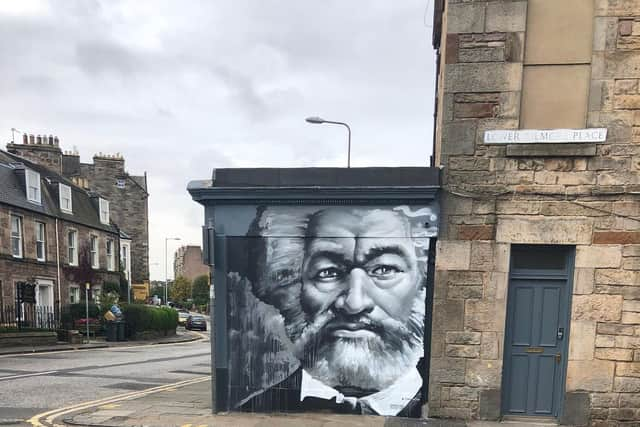Edinburgh mural appears on street corner showing slavery abolitionist leader Frederick Douglass
and live on Freeview channel 276
The new mural, spotted earlier this week on Lower Gilmore Place, exhibits a powerful portrait of Frederick Douglass, the former slave who became one of the most prestigious antislavery agents of his time.
The artist is not yet known, but Douglass’s powerful gaze is hard to miss for any passerby.
Advertisement
Hide AdAdvertisement
Hide AdThe abolitionist arrived in arrived in Edinburgh in 1846, eight years after escaping the brutal regime of his owner on a plantation in Maryland.
Following his escape, Douglass became a leading light in the US abolitionist movement and was sent to Great Britain on a speaking tour to seize strong anti-slavery sentiment at a time when the US lagged in efforts to wholly outlaw the trade.
His trip, organised by the American-Anti-Slavery Society, was also to keep Douglass out of reach for his former owner, Captain Thomas Auld, who under law could still claim him as his property.
In a letter home to his friend William White, dated July 30 1846, he wrote not only of the city’s “conglomeration of architectural beauties” but the warm welcome that he experienced there.


Advertisement
Hide AdAdvertisement
Hide AdThe letter, held by Gilder Lehrman Center for the Study of Slavery, Resistance, and Abolition at Yale University, said: “You will perceive that I am now in Edinburgh. It is the capital of Scotland, and is justly regarded as one of the most beautiful cities in Europe.
“I never saw one with which for beauty elegance and grandeur to compare it. I have no time even had I the ability to describe it. You must come and see it if you ever visit this country. You will be delighted with it I am sure. The Monument to Sir Walter Scott, on Princes Street is just one conglomeration of architectural beauties.
“The Calton Hill, Salisbury Craggs and Arthur Seat give the city advantages over any city I have ever visited in this or in your country.
“I enjoy every thing here which may be enjoyed by those of a paler hue—no distinction here. I have found myself in the society of the Combes, the Crowe’s and the Chamber’s, the first people of this city and no one seemed alarmed by my presence.”
A message from the Editor:
Thank you for reading this story on our website. While I have your attention, I also have an important request to make of you.
The dramatic events of 2020 are having a major impact on many of our advertisers - and consequently the revenue we receive. We are now more reliant than ever on you taking out a digital subscription to support our journalism.
Subscribe to the Edinburgh Evening News online and enjoy unlimited access to trusted, fact-checked news and sport from Edinburgh and the Lothians. Visit https://www.edinburghnews.scotsman.com/subscriptions now to sign up.
By supporting us, we are able to support you in providing trusted, fact-checked content for this website.
Joy Yates
Editorial Director
Comment Guidelines
National World encourages reader discussion on our stories. User feedback, insights and back-and-forth exchanges add a rich layer of context to reporting. Please review our Community Guidelines before commenting.